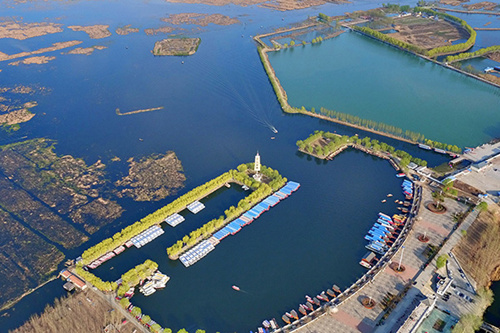
. > WHAT'S NEW > TOPLINE
Xiongan New Area to drive green regional integration
Author : CHEN ALONG Source : Chinese Social Sciences Today 2017-04-18

Aerial photo taken on March 31 shows Baiyangdian, North China’s largest freshwater wetland, in Anxin County, Hebei Province.
China announced plans for Xiongan New Area in Hebei Province on April 1.
The new area is to be located about 100 kilometers southwest of downtown Beijing and will include three counties: Xiongxian, Anxin and Rongcheng. It is home to Baiyangdian, one of the largest freshwater wetlands in North China.
The new area will be as important as the Shenzhen Special Economic Zone in the South and the Shanghai Pudong New Area in the East. It will serve as a new economic engine and advance the coordinated development of the Beijing and Tianjin municipalities with Hebei Province, which is collectively known as the “Jing-Jin-Ji” region.
A circular issued by the Communist Party of China (CPC) Central Committee and the State Council described the move as a “major historic and strategic choice” that would be “crucial for the millennium to come.”
The Circular suggests that the new area will be the destination for a mass relocation of many of the non-capital functions of Beijing, said He Lifeng, minister of the National Development and Reform Commission. The current population of Beijing has reached more than 21 million, approaching the limit set by the Beijing Municipal Government, which vowed to prevent the capital’s population from reaching 23 million before 2020, he said.
Such big city problems as traffic congestion, soaring property prices and limited resources are also deeply rooted in the fact that Beijing bears too many other functions in addition to its role as a capital city, he said.
Zhang Junkuo, deputy director of the Development Research Center of the State Council said compared with other well-known world-class city clusters, Jing-Jin-Ji region has four obvious weaknesses:
First of all, the economic scale is smaller than other major global city clusters. And the structure and layout of cities in this region is irrational, lacking second-class cities with comprehensive competence. Furthermore, the urbanization of Hebei Province, in terms of both developmental level and quality, should be further improved.
There is no city with sufficient strength and capacity to drive and connect regional development, especially in central and southern Hebei Province, Zhang said. The way the new area has been designed will favor the coordinated resolution of these problems, he said.
Xu Kuangdi, head of the expert advisory committee of the coordinated development of the Jing-Jin-Ji region and honorary president of the Presidium of the Chinese Academy of Engineering, said the location of the new area was selected after repeated discussion and deep debate on transportation, geology, hydrology, construction costs and other factors.
Xiongan New Area sits at the center of the triangular area formed by Beijing, Tianjin and Hebei’s provincial capital Shijiazhuang. The new area has obvious locational advantages and convenient traffic, He said. The existing superhighways and railways enable a half-hour commute circle connecting Beijing, Tianjin and Shijiazhuang, he said.
It is easier to draw a picture on blank canvas. The three counties that the new area covers reported a combined GDP of about 20 billion yuan ($2.94 billion) last year, less than 1 percent of Beijing’s economic output. He said the area is currently underdeveloped, which also means it has tremendous potential for further development, demonstrating basic conditions for development with high starting point and high standards.
In the early stages, the new area will cover about 100 square kilometers. And it will be further expanded to 200 square kilometers in the mid-term and ultimately, it will cover about 2,000 square kilometers.
One of the seven major tasks of the new area is to build a world-class, green, modern and smart city. Xu suggests that the establishment of a new area should forge a new path. The new area will pursue optimized development in densely populated areas. The key is to make policies adapted to local circumstances. Traditional industries should be well integrated and upgraded, creating jobs for locals, while farmers should be properly relocated and integrated into urban life, he said.
About 30 central enterprises of China began to make development plans in the new area in the last week. Effectively establishing a new engine of innovation-driven growth requires the establishment of a platform and for the government and market to fully play their roles, Zhang said.
In this way, the new area may create a relatively favorable environment for innovation resources and entrepreneurial investment, gradually attracting innovators as well as scientific and technological achievements to be transformed in the new area. Ultimately, the industrial upgrading and innovative development of Hebei Province, following the model of the new area, can be expected, he said.
The Circular suggests Xiongan New Area will prioritize ecology and green development, establishing ecologically habitable urban areas. Zhang suggested the new area can be established as a model for ecological restoration and environmental improvement.
As a national new area, it has advantages in using both central and local government resources to jointly protect the atmosphere and water environment of this region, he said. Also, the new area will also provide experience for both the city cluster and other densely populated regions regarding innovative and green development as well as environmental protection, promoting coordination on environmental protection on a larger scale, he added.
Chen Along is a reporter at the Chinese Social Sciences Today.
Ye Shengtao made Chinese fairy tales from a wilderness
Ye Shengtao (1894–1988) created the first collection of fairy tales in the history of Chinese children’s literature...
-
How northern ethnicities integrated into Chinese nation
2023-09-18
-
Mogao caves
2023-09-12
-
Mogao Grottoes as ‘a place of pilgrimage’
2023-09-12
-
Time-honored architectural traditions in China
2023-08-29
-
Disentangling the civilizational evolution of China
2023-08-28
-
AI ethics in science fiction
2023-08-23













 2011-2013 by www.cssn.cn. All Rights Reserved
2011-2013 by www.cssn.cn. All Rights Reserved